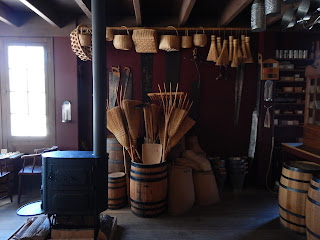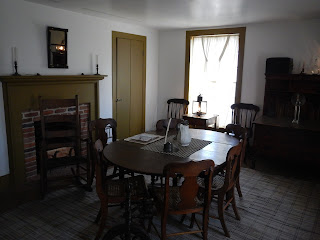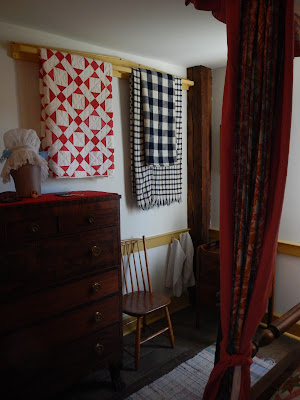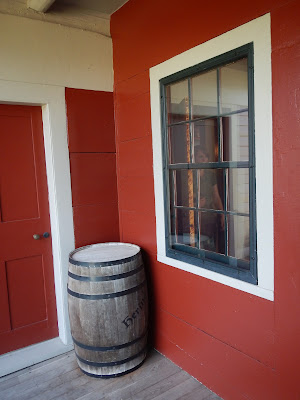Thursday morning we were up and on the road early, early. We had many miles to go before we slept. Not knowing if we would ever be this way again, we agreed that we had to make the trek to Kirtland, Ohio. We traveled south to Corning again and jumped on Interstate 86 going west. It was time to try a new route. It was more rural and forested than the 90 to the north. We even saw a black bear attempting to cross the Interstate!
Pennsylvania made sure that they would have some shoreline along Lake Erie when made a state, so we met up with Interstate 90 again near Erie, Pennsylvania. Once we were in Ohio, things slowed down dramatically. In fact traffic stopped. There were miles and miles of construction. Thus you have the picture above taken from the Interstate. This is very typical of the countryside in Ohio.
We finally found an exit and meandered the back roads to Historic Kirkland, two hours behind our planned agenda time. We found a beautifully manicured pathway lined with historic homes, buildings, and work sites. Historic Kirtland was completed in 2003.
We had joined a tour of the grounds led by two lovey sister missionaries. First stop was the Newel K. Whitney Store.
Joseph Smith was welcomed here by Newel and his wife.
Back in the 1830's all kinds of goods could be found in a store like this one.
Fine china.
Thread and fabric.
Household goods.
This room upstairs was turned over to Joseph and Emma for living quarters.
The room across the hall was used for The School of the Prophets.
A view out a window.
Smith bedroom.
Stairway to cellar used for storage.
The kitchen located beneath the School of Prophets room.
This was Emma's kitchen during her time here.
The Whitney's lived in this home.
It is just west of the store.
This is the home's front garden. That is the John Johnson, Sr. Inn in the background.
We entered the Whitney home through the kitchen.
It was off to the side of the main building so that it would not further heat up the house during the summer.
Work room.
The sister missionary had just shared how Joseph Smith had healed Elsie Johnson in this home and her following conversion to the Church. Glen is sharing his stories of healing in Paraguay on his mission which resulted in baptisms, explaining that it still happens.
The front parlor.
The bedroom that Emma first used as she neared the end of her pregnancy.
Quilt holder.
Some of the buildings are original. The Whitney store is 85% original. Others are rebuilt but on existing foundations as was the Johnson Inn. Before we left on our trip, I read this interesting article about the restoration of Church historic sites.
The Johnson Inn is now another visitor center and meeting place. It was first built in 1827 and after John Johnson took it over it was an inn as well as a printing office, gathering room which held 50, and well as the place where the Egyptian mummies were displayed.
The grounds and surrounding areas are beautiful.
On the south side of Historic Kirtland are a recreated sawmill and ashery.
The sawmill was busy during the Kirtland Period of 1831-1838 when Latter-day Saints gathered here, built homes and a temple.
The sawmill could operate with just two inches of running water.
It was also a workshop for carpenters.
Furnishings for the temple were created here.
The ashery next door was also owned by Newel K. Whitney.
People would bring their ashes here for processing.
This was the office.
The ashes would be combined with water and then boiled until the water was gone and potash remained.
The potash was used in the production of many items. It sold for $100 a bag.
Potash could be further purified in these ovens.
It would turn white in color and sold for $200 a bag.
This was very lucrative for Mr. Whitney.
This is one of the original kettles found underground at the site.
Collection bins.
Lovely flowers in front of the ashery.
At the east end of the walkway is the Kirtland School.
It sits near the Visitor's Center which first welcomes visitors.
After the tour, we jumped in the car and headed south up the hill to the Kirtland Temple. The street signs testify to the former residents.
The temple is in the hands of the Church of Christ (formerly know as the Reorganized Church of Jesus Christ of Latter-day Saints) and they provide the tours which are $3 per person. They, too, have a visitor center with museum and gift shop. They first have everyone meet in an auditorium for a video. After the video, the screen goes up, the window coverings open, and the temple comes into view.
Pictures are not allowed inside the temple but are welcomed of the outside once the tour is over. This is the original color of the doors.
I loved the detail both inside and out.
Wonderful, spiritual things occurred in this building as it was being dedicated those many years ago.
We were allowed on the first and second floors but not the third with the dormer windows.
We then traveled about 30 miles south to Hiram, Ohio to the John Johnson Farm. Joseph Smith found a place to live here in 1831 - 1832. It provided a quieter, calmer place to work than the Morley Farm.
One enters the home through the former carriage house.
The back wall of the home was painted red.
Once again the kitchen was on the side of the main dwelling between it and the carriage house.
The Johnson family had lived in the area for many years and had saved money for a long time to build this beautiful home. This meant that they had a water pump right next to the dry sink.
Once again, I love how the historical teams take us back in time.
Small downstairs bedroom which might have been used to take care of the sick, elderly, or as a borning room.
This home was at the height of fashion for its day which included this stylized painting on the doors and other woodwork.
This included the main house fireplace.
Office room. This home also had small closets which was very rare as closets were considered an additional room for taxation.
The front parlor.
This is also where the Johnsons would have studied and learned with the Prophet.
The main floor bedroom which was turned over to the Smiths during their time in this home.
It would have been considered the master bedroom, so the Johnsons were very generous.
There were many bright colors in this home including this checkerboard painted wood floor.
Upstairs bedroom. There was also a sleeping loft over the kitchen if needed.
Sewing, weaving, and work room.
Upstairs room that Joseph used for an office. This was also the location of Conference when it was decided to compile and print the first Doctrine & Covenants.
Glen standing at the front door with the sister missionaries.
All the sisters that we met were so well spoken and knowledgeable about the sites. They could answer all my questions and also shared their testimonies with conviction.
While Joseph lived here he would preach from the front steps. A bowery would be constructed for the comfort of those listening. Another interesting note about the Johnson Farm, the Snow family lived just a mile and a half west of the Johnsons. Their home also still stands but is now a private residence. For more about the Johnson family go here.
This is also the place where Joseph was pulled from his bed, dragged from the home and tarred and feathered. Sidney Rigdon was staying at a home across the road and was also tarred and feathered. The Murdock twins which the Smiths adopted were in the same bedroom and had the chicken pox. The exposure on this night caused the death of the little boy. Julia Murdock survived.
Side entrance to the home which led upstairs to Joseph's office room.
Once again, the grounds are lovely and the house is still surrounded by a beautiful working farm.
It was after 5 pm when we finished our tour. We already knew that we would take more back roads to avoid the construction on the 90. The sisters directed us to Middlefield for supper. This was Amish country and we enjoyed a delicious meal at Mother Yoder's Kitchen and Gift Store. It was a beautiful drive through well kept farms but sometimes we shared the road with Amish buggies. I know that they do not like to have their pictures taken but I thought this far off shot might be okay.
It was fascinating to watch American Experience this week which was entitled "The Amish." One of the places featured on the show was Middlefield, Ohio which has the fourth largest Amish community in the world.
We took Interstate 90 back, joining it just before reaching the Pennsylvania border. Once we crossed into New York, it became the Interstate 90 New York Thruway. That means that it becomes a toll road. We had traveled many times before between Buffalo and the Palmyra area. Pennsylvania to Buffalo was new for us and there were glimpses of Lake Erie from the roadway as the sun set.
We hit the Palmyra/Manchester exit just as the Hill Cumorah Pageant was over. That meant we were back at the Driftwood just before midnight once again. It was a long 18 hour day and we drove as far as we do between Mesa and Provo, but it was worth every minute.




















































































No comments:
Post a Comment